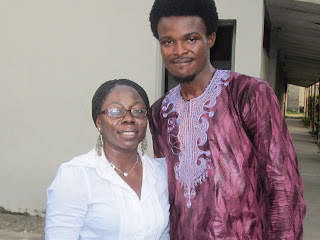It was August 2009, and I had decided to start writing full time a few months earlier. I had joined a writing group and somebody suggested blogging too. Since then, my blog has proved indispensable. I had started first by sharing my work-in-progress and as feedback poured in, I was encouraged and inspired to continue. Honestly I love being read and that is the opportunity I appreciate most of all from blogging. I also want to get better and blogging is the perfect way to sample a wide variety of opinion. Not all criticism is constructive of course and it helps that I can discuss these comments with my writing group. I have also taken part in several writers’ blogfests, which are useful not only because of the writing involved but the critique from fellow writer-bloggers. This way I’ve received professional feedback on my writing exercises, scenes from my WIP, and short story drafts.
In addition to my writing group and blogging, I polished my writing craft and style through freely available online writing courses. The critique from my writing group showed that they were taking effect on my work. Soon, I wrote ‘The End’ to my WIP, which had grown from a novella to a complete manuscript, and I began to shop for publishers. I queried traditional publishers in the United States but their replies showed that they preferred a story set in the US which was their major market or if it had to be African, then literary fiction. I really wanted to tell a contemporary Nigerian story which Nigerians would love to read something simple and easy to read. So I looked to Nigeria but there were not that many publishers and the few I discovered appeared resource constrained.
So I began to study alternative means of publishing. I researched Lulu – whom I actually used for an initial eBook – Authorhouse, and other so-called Vanity Presses. I kept an open mind as I read the testimonials of those who had used them in the recent past. I found that most of the successful ones were full-time writers and they’d had a prior audience before self publishing. As both of these factors described me too, I saw that this avenue was worth a try. Others factors I considered included the fact that the publishing world has begun to come to terms with the internet age and Print-on-Demand (POD) was becoming a valid choice of getting a book to an audience. The new technology and the advent of eBooks and e-readers like kindles, Nooks , etc. meant that the cost of producing books were no longer too exorbitant for an individual.
My decision was made when I considered who I wanted to be my audience. Most of my blog followers had been reading A Heart to Mend as excerpts on my blog and I wanted to give them a chance to read the whole story. I also found out that most publishers would not accept a manuscript that had been published online and so my traditional publishing choices were limited. Also, I knew that this story was just a first outing and there were several more stories to come. So I said to myself; “traditional publishers could come later if necessary, self-publishing it is!” My earlier research had shown that I needed a way to take some of the burden off and I chose AuthorHouse because they assign an author a production team. I also liked that they had access to the major retailers in America, Europe and the UK and a lot of author resources to guide one through the stages of marketing and publicity.

Delivering my paper on the interactive session I facilitated at the Garden City Literary Festival on the "Rise of social Media and the Nigerian book publishing industry".
The main advantage of self-publishing for me is that as the author, I have full control over the content, design, and marketing of my book. I also decide when it goes to press and I retain all the publication and subsidiary rights. I was thus free to penetrate a niche market like Nigeria, which a commercial publisher outside of Nigeria would have ignored. (I know of several books by Nigerians, set and written in Nigeria but published in the UK or USA, which are yet to be distributed in Nigeria). I also believe that my book had a greater chance of success because I was very committed to promoting it, more than say, a publisher who has hundreds of other titles. In terms of sales, A Heart to Mend has been doing relatively well and I get most of the net revenue. I want to point out that apart from the commercial success, there’s also that deep satisfaction of knowing your creative work is out there making and contributing to conversation. A Heart to Mend was published in December 2009 and I am always amazed by the number of people who have read the book from all around the world.
On the flip side, self-publishing is expensive and requires a capital outlay to begin with rather than an advance you may receive from a traditional publisher. Even when my book came out, I had to invest further time and money in the publicity and marketing. If I had been published traditionally, I could’ve left all that to the agents and publishers and gone back to my next project. Not so with self-publishing, I had to put in a lot of effort and energy to get A Heart to Mend buzzing. A hurdle to be aware of is that a lot of media organizations still do not review, distribute or feature self-published books.
You can understand why I will always be grateful for the vehicle the internet provides to a writer and published author like me to get my book out there. Setting up an active blog and publishing my book has served a double purpose for me; finding out the target audience for my kind of writing and building a platform too. If not for the social networking channels, A Heart to Mend would never have gone viral the way it did. It was through the support of bloggers that I did my first blog tour for A Heart to Mend with the attendant publicity. By the end of that blog tour, I was getting requests for interviews and features almost daily. I put up chapter one of the book on a free reading website and it became a massive hit. It remained in the top 10 for three consecutive months!
The beauty of the internet was that I could remain in my work room with just my laptop and a connection, and meet up with these dozens of interviews. As time went on, I continued networking with other writers and self-published authors and I as I shared what I had learnt, I picked up some good nuggets from them too. I set up a twitter page and opened up my facebook profile for use with my pen name. As I became more adept at using the word-of-mouth tools on those two sites, the visibility of A Heart to Mend quadrupled. I learnt how to interconnect these media, how to set up scheduled tweets or how to update Facebook via RSS feeds, etc.
The challenge of using social networking is that of distraction. For me personally, Facebook has proved the most addictive. I find that sometimes while updating my pages, I may stray into something else entirely and so on, thereby wasting precious amounts of time that could have been put to better use. There was a day I took a break from writing and as usual, the first point of call was Facebook. The site was down, and I kept refreshing it for almost five minutes before it dawned what I was doing. I laughed at myself, left a message on Twitter about my addiction and went to check some other things. I had to really think that day but it is what it is. Apart from work, Facebook is also the only place I can keep in contact with all my family and most of my friends.
Finally, I think the reason social networking worked so well for me as a writer and publisher is because I am a social person. During the times I am not writing, I enjoy the company of other like-minded people and being able to use the internet and social networking to connect to more and more people in my writing life is a thing of learning and also of pleasure. At the end of the day, I have to find a way to balance the two by making sure that my internet use is mostly purposeful and in a way that is linked to my writing and also setting out a specific time for my writing itself without any distractions. That way, I still get a lot of writing done while remaining in the social circles.
________________
An edition of this article was published in the
Saraba Magazine, Issue 7 - Technology
















































